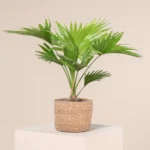From Finicky to Flourishing: The Ultimate Guide to Fiddle Leaf Fig Care

Categories: Houseplants, Indoor Trees, Statement Plants, Tropical Plants, Instagram-Favorite Plants
Introduction:
The Fiddle Leaf Fig (Ficus lyrata) has risen to stardom in the world of indoor plants, becoming a true icon of interior design. Native to the tropical rainforests of Western Africa, this striking plant is characterized by its large, violin-shaped leaves that create a bold, architectural presence in any space.
Originally growing as an understory tree in its native habitat, the Fiddle Leaf Fig can reach heights of up to 40-50 feet in the wild. As a houseplant, it typically grows to a more manageable 6-10 feet tall, making it an impressive indoor tree that adds instant drama to interiors.
The plant’s botanical name, Ficus lyrata, refers to its genus (Ficus, which includes all fig trees) and its lyre-shaped leaves (lyrata). Its journey from obscure tropical tree to interior design darling began in the mid-20th century but truly exploded in popularity in the 2010s, largely driven by its photogenic qualities and prevalence in home decor magazines and social media.
Real-world event: In 2020, during the COVID-19 pandemic, there was a surge in houseplant sales, with the Fiddle Leaf Fig being one of the most sought-after plants. This “plant boom” led to shortages and increased prices for many popular houseplants, including the Fiddle Leaf Fig.
Care Guide:
- Light: Bright, indirect light is crucial. Can tolerate some direct morning sun.
- Water: Allow top 1-2 inches of soil to dry between waterings. Consistent moisture is key.
- Humidity: Prefers higher humidity but can adapt to average home conditions.
- Temperature: Thrives in 60-75°F (15-24°C). Avoid cold drafts and sudden temperature changes.
- Fertilizer: Feed monthly during growing season with a balanced, water-soluble fertilizer.
Soil and Potting/Repotting:
- Soil: Well-draining, slightly acidic potting mix. Add perlite or orchid bark for improved drainage.
- Potting: Choose a pot with drainage holes, only 1-2 inches larger than the current one.
- Repotting: Every 18-24 months or when rootbound, preferably in spring.
Health and Diseases:
- Common pests: Spider mites, scale insects, mealybugs
- Diseases: Root rot, leaf spot diseases
- Prevention: Proper watering, good air circulation, regular leaf cleaning

Business: How to Make Money and Beyond
- Propagation and Sales:
- Propagate through stem cuttings or air layering
- Sell rooted cuttings or young plants online or at local nurseries
- Plant Styling and Rental:
- Offer interior design services featuring Fiddle Leaf Figs
- Start a plant rental business for events and photo shoots
- Content Creation:
- Create a niche blog or YouTube channel focused on Fiddle Leaf Fig care
- Develop and sell e-books or online courses on advanced care techniques
- Specialty Products:
- Design and sell custom planters or plant stands for Fiddle Leaf Figs
- Create plant care kits specific to Fiddle Leaf Figs

Variety and Price Table:
| Variety/Size | Average Price (USD) |
|---|---|
| Small (2-3 ft) | $30 – $75 |
| Medium (4-5 ft) | $100 – $200 |
| Large (6+ ft) | $200 – $500+ |
| Variegated Fiddle Leaf Fig | $150 – $300+ |
| Dwarf variety (Bambino) | $25 – $60 |
Regional Price Comparison Table:
| Country/Region | Average Price (Local Currency) |
|---|---|
| USA | $75 – $200 USD |
| UK | £60 – £150 GBP |
| Australia | $100 – $250 AUD |
| Canada | $90 – $220 CAD |
| Germany | €70 – €180 EUR |
FAQs:
- Q: How often should I water my Fiddle Leaf Fig?
A: Water when the top 1-2 inches of soil are dry, typically every 7-10 days. - Q: Why are my Fiddle Leaf Fig’s leaves dropping?
A: Often due to overwatering, underwatering, or sudden environmental changes. - Q: Can I grow a Fiddle Leaf Fig outdoors?
A: Yes, in USDA zones 9-11. In colder areas, it can be a summer patio plant. - Q: How do I propagate my Fiddle Leaf Fig?
A: Through stem cuttings or air layering, best done in spring or early summer. - Q: Why are the leaves on my Fiddle Leaf Fig turning brown?
A: Could be due to low humidity, overwatering, or fertilizer burn. - Q: How fast do Fiddle Leaf Figs grow?
A: They’re moderate growers, adding 1-2 feet per year under ideal conditions. - Q: Do Fiddle Leaf Figs need pruning?
A: Pruning helps maintain size and shape, and encourages bushier growth. - Q: Are Fiddle Leaf Figs toxic to pets?
A: Yes, they’re toxic to cats and dogs if ingested. - Q: How do I clean the leaves of my Fiddle Leaf Fig?
A: Gently wipe with a damp cloth to remove dust and improve photosynthesis. - Q: Can Fiddle Leaf Figs tolerate low light?
A: They prefer bright light; low light will result in slow growth and potential leaf drop.

Quick Facts Table:
| Attribute | Detail |
|---|---|
| Scientific Name | Ficus lyrata |
| Common Names | Fiddle Leaf Fig, Banjo Fig |
| Native Region | Western Africa |
| Plant Type | Tropical tree |
| Mature Size | 6-10 feet tall indoors |
| Growth Rate | Moderate |
| Leaf Size | Up to 12-18 inches long |
| Flowering | Rarely flowers indoors |
| Light Requirement | Bright, indirect light |
| Water Requirement | Moderate |
| Humidity | Prefers higher humidity |
| Temperature Range | 60-75°F (15-24°C) |
| Soil Type | Well-draining, slightly acidic |
| Toxicity | Toxic to pets if ingested |
| Propagation Methods | Stem cuttings, air layering |
| Common Uses | Indoor ornamental, statement plant |
Fiddle Leaf Fig, Ficus lyrata, indoor tree, large houseplant, statement plant, tropical decor, plant care, interior design, Instagram plant, urban jungle

Views: 6







